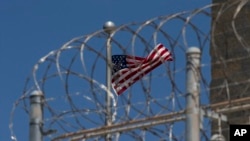The United States on Monday released Abdul Latif Nasser, a one-time Taliban commander in Afghanistan, from its detention center in Guantanamo Bay, Cuba, sending him to his native Morocco after holding him for 19 years.
It was the first transfer of a Guantanamo detainee under U.S. President Joe Biden. A senior administration official told reporters the U.S. is “very much focused,” subject to national security reviews, on transferring more Guantanamo prisoners to other countries willing to take them and closing the prison.
The release of Nasser, 56, to Morocco five years after senior U.S. officials first determined he was no longer a significant threat to U.S. security, leaves 39 prisoners at Guantanamo.
The facility on the eastern tip of Cuba once housed more than 700 terrorism suspects in the aftermath of the September 11, 2001, al-Qaida terrorist attacks on the U.S. But human rights activists often assailed the U.S. for its operation of the highly secure prison, asserting the detention of such a large number of fighters captured on battlefields throughout the Mideast and South Asia was excessive and their treatment at Guantanamo inhumane.
The White House says that Biden wants to close the Guantanamo facility by the end of his four-year term in the White House. Of the 39 remaining prisoners, the White House says that 10 already are eligible for transfer to other countries, 17 are eligible for further review, 10 are involved in the military commission trial process and two have been convicted.
U.S. officials said they were grateful to Morocco for accepting the transfer of Nasser, although it was unclear whether he would be freed or his detention prolonged. The Pentagon made reference to “security and human treatment assurances” that Morocco gave the United States.
Nasser first had been cleared for release in 2016, near the end of the administration of former President Barack Obama, who unsuccessfully sought to close Guantanamo but did transfer 170 prisoners to their home countries or third countries during his eight years as the U.S. chief executive.
Obama’s successor, former President Donald Trump, transferred only one prisoner – to Saudi Arabia, so he could serve out his sentence there. Trump opposed the closure of Guantanamo and threatened to send more prisoners there.
Hina Shamsi, director of the national security project for the American Civil Liberties Union, called Nasser’s release “an encouraging development.” She called it “a travesty” that Nasser “continued to languish at Guantanamo after being cleared for transfer to Morocco five years ago.”
Nasser was brought to Guantanamo Bay in May 2002 after fighting for the Taliban in Afghanistan, where he operated as a commander and weapons trainer.
One of the senior Biden administration officials who briefed reporters on a background call said, “We have undertaken a responsible transfer.”
The official added, “The Biden administration remains dedicated to a deliberate and thorough process focused on responsibly reducing the detainee population and ultimately closing of the Guantanamo facility.”
“I want to underscore that, as we've demonstrated today, the Biden ministration will apply all the necessary diplomatic resources to facilitate the transfer of detainees found eligible,” the official said.
Steve Herman contributed to this report from the White House.








